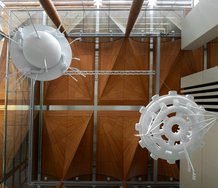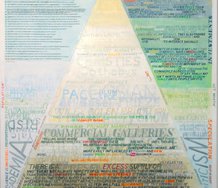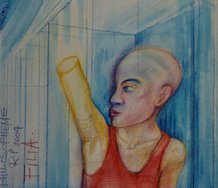Ralph Paine – 20 May, 2024
The Girl is perhaps Deleuze and Guattari’s most remarkable (and revolutionary) “conceptual personae,” the most exemplary of their philosophically invented subjects. She is a mode of existence, a wonderful possibility of life, a vital figure whose role is to show thought’s territories. Deleuze and Guattari: “She never ceases to roam upon a body without organs. She is an abstract line, or a line of flight.”
EyeContact Essay #52
2066. Dogs barking early morning, from out of her desert wandering a young seer came down to the city—any-city-whatever—as the Stranger. Seized by the infinite distance she was from, with beautifully bloodshot eyes and a head full of arcana, smiling, odd clothing, a satchel on her back stuffed with ragged notebooks and papers—this changed everything.
*******
A possible formula: when conjuring transindividual magic, always begin from afar. From the way-out-there. Infinite blue desert. The surrounding sprawl. And then come down to the city. Dirty old port. To there where things seem most piled up, intense, labyrinthine.
OK, but hasn’t the desert already moved into the city? Hasn’t a flood-coursed and data-dust covered ruin grown and spread everywhere? Desertification. Globalisation. Zac Langdon-Pole: “Cranes dominate our skylines, building upwards and feature on the top of buildings which seem to me to be emblems of human civilisation’s so-called progress. The crane however is powered by petrol, which is a substance derived from once living fossils buried in the earth’s history. So I guess everything is connected.”(1) Zac’s ‘Sculpture in the Gulf’ work, Chimera, 2024, was best seen at sunset, silhouetted against a fiery orange sky at the End of the Day(s)… Yeah, on an already extinct Earth everything is connected. Via Apocalypse. But then what? How to process this thought? When Nature = Capital, how to re-populate the Desert of the Real. When every day seems too late, how to regain time? And when there are no longer any true Influencers but only the Influenced, how to create an audience to-come, a readership to-come?
A messy problematic of temporal processes and regeneration. Of contagion, kinship, and breeding. Of fecundity and art. Becky & Co. select a way-out-there Hal Foster quote for The Art Paper‘s currrent Masthead page: “At dinners after openings I sometimes feel like I’m watching bank accounts have sex.”(2) Which is kinda like Byung-Chul Han’s more formal and generalised claim that “capital reproduces by entering into relations with itself as another form of Capital: through free competition. It copulates with the Other of itself by way of individual freedom… Individuals degrade into the genital organs of Capital.”(3)
Yet even before the Hal Foster quote appears, as if to set its libidinous scene, Matt Ellwood’s détourned and beautifully degraded art-fashion-touristy ads expose capital’s Drive in all its scopic, multi-orgasmic glory.(4) In Magazineland—and way beyond—capital is akin to feminine jouissance, as Cixous & Clément say it, a glossy, cyclical fusion of “erotic, mystical, and economic” pulsations.(5) And more. Something more, more than Totalled or Totalising. Something obsessively compulsively excessive, dishevelled, writhing, overabundant, abandoned: a cultural throwaway enfolding devices, toys, the Silicon Phallus. Or as Becky and Co. say it, “Trophy.” Interesting that The Urban Dictionary defines ‘trophy’ as something both highly desirable and useless.
In a golden age of feminism Shulamith Firestone coined the term “sex class.” It’s a System. It runs that deep so as to seem invisible, hidden. It’s Oedipus, Electra, mommy-daddy-me, enforced domestic and reproductive work for women, traffic in women, slavery, racism, colonisation… “It pervades all culture, history, economics, nature itself.”(6) OK, so let’s conduct Revolution. Let’s end sexual repression, abolish the family, strip parenthood of its child-as-project function, and so on: Firestone’s “program” is an intricate and very concrete diagram for a possible future. For a complete makeover of history; including detailed imperatives concerning chores, legal rights, households, city planning, etc. In brief: the end of sexual repression, etc. will free Eros to diffuse throughout and naturalise the Culture. Ultimately it will lead not only to the end of alienated labour but of work as such. Technology will eliminate domestic and other drudgery, leaving everyone free to conduct labour which is intrinsically rewarding.
And in the present conjuncture? Given its fully automated luxury communism feel, Firestone’s manifesto plays back today amid a melancholic sense of revolutionary feminism’s defeat. Cybernetic ‘techno-fix’ Utopianism has been fully integrated into the current state capitalist war machine as its $urplus-making and creatively destructive OS. Amid the eternal return of old patriarchal codes, archaisms, nationalisms, fascisms, religious traditions, a negative solidarity among “the genital organs of Capital” (as Byung-Chul Han defines us) seems all that remains viable regarding any utopian visioning whatever. Negative solidarity as collective desire. Desire for that which depresses, oppresses, makes ruin.
For a long time, myriad scenes and tactical scenarios emerged. Auto-manifestations of some unique and disruptive aesthetic, ritualistic encampments, clandestine reading groups, refreshed existential refrains a là Felix Guattari, imagistic tales of the impure, witches’ flights, shamanic performances, anti-racist sports clubs, the production of hyper-strange objects and replicas, opaque resistance, becoming-minor, dreamscapes in the order of heresy, whatever-diagrams… And as such, were always intended to seed and nourish a coming awareness of there being something unfamiliar, astonishing, and radically different already at hand.
Yet today, it’s super difficult to evade precariousness, subsumption, overcoding, and enforced compliance with state-capitalist axiomatics—or simply being junked. In so many planetary zones and regions even difficult evading persecution, incarceration, torture, war, death. Here on a planet of ever-expanding slums, is a gender/ethnicity/sexuality/etc-troubled eccentricity of ideas and action (ʹ68-thought’s illustrious ‘difference’ and ‘transversality’) slowly losing its potency? The endless invention of wonderfully slant identities as a means to outmanoeuvre the dualism machines can seem increasingly redundant right now. Mostly we conceive of these identities as management problems that it is our job to resolve: it’s either professionalise or fail. Guy Debord: “Our era of technicians makes abundant use of the nominalised adjective ‘professional’; it seems to believe that therein lies some kind of guarantee.”(7) Perhaps then it’s professionalise and fail anyway. The contemporary substitution of the term ‘prostitution’ by the term ‘sex-work’ coincides directly with a generalised professionalisation occurring, just as the ‘artist’ becomes professionalised as a cultural industries worker i.e., somebody who simply performs ‘art-work.’ Artists become collaborators in, bearers of, a culture class system while remaining locked into an outwardly unbreakable sex class system.
Charles Baudelaire’s legendary account of his March 13, 1856, Brothel-Museum dream suggests a mysterious and positive something-more to be gleaned from the art-work/sex-work fusion. Modern chimera, a dreamscape where art, licentiousness, and a medico-technical museology mix; a place of passageways and vast galleries; a place where prostitutes lounge around chatting with groups of young men; where on the walls framed zoological and architectural drawings mingle with “obscene” prints by the thousands; where Egyptian sculptures stand beside displays of embalmed foetuses in jars, the Brothel-Museum complex causes Baudelaire to “reflect that modern stupidity and arrogance have their mysterious usefulness, and that often, by virtue of a spiritual mechanics, what was done for ill turns into good.”(8) Of what specific “good” Baudelaire does not say, so our only recourse here is to speculation… An artificial yet extremely intimate form of congeniality? Dream images as wildly beautiful messages delivered from the future? The Brothel-Museum complex is more than—in excess of—museology (science, rationality) + money making (prostitution)?
In her debut novel The Baudelaire Fractal, poet, art writer, and self-proclaimed she-dandy Lisa Robertson has her auto-fictional narrator Hazel Brown deliberate on the troubling fact that while Baudelaire liked hanging with flower girls, artists’ models, actresses, street singers, and prostitutes, in his intimate diaries he was more than inclined to write some real nasty shit about the persona of the Girl.(9) These diary entries shock Hazel, disgust her. She recoils, reminded yet again of how her life as a “she-reader” had been one of suffering cruelty by exclusion, shame by predestination of identity and role, and failure by too many useless attempts at “hardening up.” Yet now, at last, Hazel recounts that she has shape-shifted Baudelaire’s bad into her good: “But gradually now the Baudelairean rant against the girl began to work differently in me. This slut insinuated attractive possibilities. What if this was not a punch but a perverse invitation? The lush imbecile beckoned me in. She begged me to become something. I paused, then I became that monster … I was a girl. I entered literature like an assassin, leaking, fucking, wanting, drinking.”(10) It’s as if Hazel has been practicing a little “spiritual mechanics” all of her own; a way of duplicating and projecting the “monstrosity” of the Baudelairean girl into “a time to come.” And for the benefit of that time, “she will break open beauty.”(11)
Breaking open beauty? Somewhere in Le Peintre de la Vie Moderne Baudelaire suggests that if a painter is not able to capture “the pose, the gaze, the smile, the vital appearance of one of those creatures who the dictionary of fashion has successively classified with the coarse or malicious label of lewd woman or kept woman or cocotte or biche,” then that painter has failed to capture the fleeting essence of the modern.(12) And the “fleeting essence” of the zombie apocalypse, the dystopian here and now? Guess we’d be more inclined to say “vibe” than “essence,” or “bad girl” than “lewd woman,” but hey, Catherine Mulligan’s miraculously visceral paintings of creature-from-the-swamp appearance—all smudged-grey skin tones, fading Day-Glo hair, roughed up, puffy ‘n’ death-like—100% affirm that Baudelaire’s painting-test upholds a contemporary viability: thanks to Becky & Co. for introducing this idle reader to these paintings of girls gone AWOL. Turned-on, happy, totally here yet totally gone “figures of love” revelling in and identifying with an it’s-so-bad-it’s-good kinda world. A zone way over the line (and beyond) where monstrosity parties 24/7. (13) A là Robertson, Mulligan breaks open beauty. To the max of our attention, her images consume themselves.
*******
2066. Love is coming. Love is against history. We camped on the perimeter of an old town lost to the wind, half buried by sand, rotten walls of mudbrick and concrete block protruding rough into the distance. Fallen gates of stone. Lost Empire. Trade routes. Sugar and hashish, semiautomatics and slaves, fragrant peppercorn and ginger root, electronic components. Golden jackals live here now, fixing our gaze at dusk. Circling. Love is coming.
*******
The Girl is perhaps Deleuze and Guattari’s most remarkable (and revolutionary) “conceptual personae,” the most exemplary of their philosophically invented subjects. She is a mode of existence, a wonderful possibility of life, a vital figure whose role is to show thought’s territories.(14) Deleuze and Guattari: “The girl is certainly not defined by virginity; she is defined by a relation of movement and rest, speed and slowness, by a combination of atoms, an emission of particles: haecceity. She never ceases to roam upon a body without organs. She is an abstract line, or a line of flight. Thus girls do not belong to an age group, sex, order, or kingdom: they slip in everywhere, between orders, acts, ages, sexes: they produce n molecular sexes on the line of flight in relation to the dualism machines they cross right through.”(15)
In 2001 Tiqqun publish a report claiming that the entire revolutionary potential of D&G’s Girl had by then been captured, integrated within, and utilised by the state capitalist war machine—aka Empire—for its own malign purposes.(16) For Tiqqun, the Young-Girl—as they rename her—had thus become the capitalist collaborator par excellence. A commodity in herself, the total and totalising force of all consumption and all advertising, model citizen, a voided being that “no longer has any intimacy with herself except as value, and whose every activity, in every detail, is directed to self-valorisation,” and thus a being who at each moment “affirms herself as the sovereign subject of her own reification.”(17) Tracking through a disturbing series of fragmented and quotational sections—the material, the data—Preliminary Material follows the nihilistic shit-fate of the Young-Girl from her manifestations as ‘Phenomenon’ and ‘Living Currency’ to her being ‘Against Communism’ and ‘Against Herself.’ Self-harming, generic product, a “refrigerated consciousness living in exile in a plasticized body,” the Young-Girl knows how to adapt to anything and is proud of it. In the final section ‘Putting an End to the Young-Girl,’ Tiqqun turn in theoretical exasperation to the negation of her own negation as being pretty much the only solution for waylaying the Young-Girl’s tragic destiny as capitalist exemplar: “In certain extreme cases, one sees the Young-Girl turning the void within her against the world that made her what she is. The pure void of her form, her profound hostility to everything that is, will condense into explosive blocs of negativity. She will have to ravage everything that surrounds her.”(18) Turn it into a desert.
*******
2066. This emptiness? A place of desolation. Remembrance of a fusion that has not yet taken place and of a destruction that already exists. An equivocation in which past and future are inextricable, clasped, and incapable of coming apart. What already was, what never was, these re-callings intermingle to cover over what is not. And afterwards? A commoning of bodies is to be expected. There’s an old saying coming from the Desert which goes something like this: “We have less cause to fear the coming day than to beware of what happened yesterday.”
Ralph Paine
(1) https://www.the-art-paper.com/journal/zac-langdon-pole-sotg Also see https://www.the-art-paper.com/journal/print-archive-endless-permanence
(2) The Art Paper Issue 05 Trophy, p. 7.
(3) Byung-Chul Han, Psychopolitics: Neoliberalism and the New Technologies of Power, London and New York: Verso, 2017. pp. 3 - 4.
(4) The Art Paper Issue 05 Trophy, pp. IFC - 5.
(5) Héléne Cixous and Catherine Clément, The Newly Born Woman, trans. Betsy Wing, Minneapolis & Oxford: University of Minnesota Press, 1986, p. 165.
(6) Shulamith Firestone, The Dialectic of Sex: The Case for Feminist Revolution, London: Paladin, 1972, p. 11.
(7) Guy Debord, Panegyric, London & New York: Verso, 2004, p. 51.
(8) As cited in Roberto Calasso, La Folie Baudelaire, trans. Alastair McEwen, New York: Farrar, Straus & Giroux, 2012, p. 133.
(9) Lisa Robertson, The Baudelaire Fractal, Toronto: Coach House Books, 2020, p. 106.
(10) Ibid, pp. 106 - 07.
(11) Ibid, p.136.
(12) As cited in Roberto Calasso, Tiepolo Pink, trans. Alastair McEwen, London: The Bodley Head, 2010, p. 15.
(13) The Art Paper Issue 05 Trophy, pp. 98, 100, 102.
(14) On conceptual personae see Gilles Deleuze and Felix Guattari, What is Philosophy?, trans. G. Burchell and H. Tomlinson, New York & London: Verso, 1994, pp. 61 - 83.
(15) Gilles Deleuze and Felix Guattari, A Thousand Plateaus: Capitalism and Schizophrenia, trans. Brian Massumi, Minneapolis: University of Minnesota Press, 1987, pp. 276 - 77.
(16) Tiqqun, Preliminary Material for a Theory of the Young Girl, trans. Ariana Reines, Los Angeles: Semiotext(e), 2012. For a counter claim see Elisabeth von Samsonow, Anti-Electra: The Radical Totem of the Girl, trans. Anita Fricek and Stephen Zepke, Minneapolis & London: University of Minnesota Press, 2019. Inspired by both Luce Irigaray’s writings on the mother-daughter relationship and D&G’s twinned notion becoming-woman/becoming-girl, von Samsonow’s indispensable text traces the “latency” of the Girl from its emergence in a mythic pre-Oedipal constellation all the way to its “impregnation” of the contemporary world as the source of all positivity of technique (art and media) and “staying-connected”: the Girl is the electric body, the body electric, a constructor of circuits and paths away “from krypto-earth and earth-oblivion.” p. XXII.
(17) Tiqqun, Preliminary Material for a Theory of the Young Girl, p.18.
(18) Ibid, p. 132.



 Two Rooms presents a program of residencies and projects
Two Rooms presents a program of residencies and projects Advertising in this column
Advertising in this column



This Discussion has 1 comment.
Comment
Ralph Paine, 9:17 a.m. 14 June, 2024 #
https://www.e-flux.com/journal/146/612281/pussy-capital/
Participate
Register to Participate.
Sign in
Sign in to an existing account.